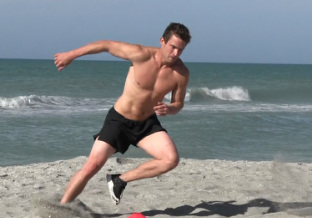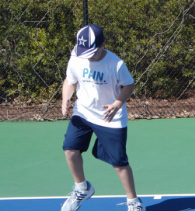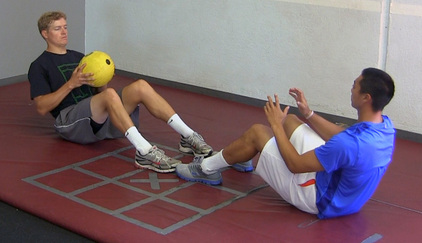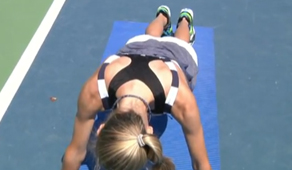www.itpamembers.org
|
Guest video blog post by iTPA Certified Member Dean Hollingworth, CTPS on the Dynamic Warm Up. This video is part 1 in a 2-part series. For the second video, check later this week on the iTPA Inner Circle Member Only Website. Exclusive content like the second part of this video is posted on the member only website. www.itpamembers.org
0 Comments
Exercise: Slalom Agility Run in Sand The “Slalom Agility Run in Sand” exercise shown in the video is one of the best overall movement exercises for any athlete who is looking to improve his/her ability to change direction quickly – especially in lateral and multi-directional movements. The exercise can be performed on grass, hardcourts, claycourts or sand. The exercise shown is performed on sand and this increases the recruitment of the larger muscles to help the athlete push forcefully into the ground and also stresses the smaller muscles of the lower body to help stabilize during the forceful eccentric muscle actions involved in the deceleration required at each of the cones. Then the athlete needs to push forcefully into the sand to be able to re-accelerate to move to the next cone. This is a challenging exercise for most athletes; it is rather common for athletes to feel some muscle soreness (DOMS) the first 48-72 hours after performing a series of sand movements. Start this exercise performing 6 cones spaced at 10 yards apart in a slalom pattern. Perform 10 repetitions of the sprint from cone 1-6 proving 60-120 seconds rest to work on explosiveness. If using this exercise for tennis-specific endurance work, then perform 20 repetitions with 20-30 seconds rest between each repetition. Watch the below video by iTPA Certification Commissioner Dr. Don Chu on Myths Surrounding Young Athletes doing Plyometric Training. Current special on iTPA Plyometrics for Tennis DVD course: Through Sunday, August 4th, 2013, use coupon code Plyo and receive 20% off! Watch the below video by iTPA Certification Commissioner Dr. Don Chu on Why Plyometric Training is so Important for Tennis Athletes. Also check out the Plyometrics for Tennis DVD course. Watch the below iTPA video demonstrating and discussing the Overhead Squat Stability Progression. This is a rather simple exercise, but is an important exercise for tennis athletes as it helps to develop functional flexibility, strength and stability in the lower body as well as control of the muscles around the lower back and abdominals (core). All these factors are important for every tennis player. This movement should be taught to tennis players and if performed at least three days per week will provide a noticeable benefit in only a few weeks. It is recommended to add this movement to a weekly routine to improve and/or maintain stability and mobility. Performing 2-3 sets of 10-12 repetitions is recommended. As the athlete improves, greater range of motion can be attempted and even adding resistance may be appropriate for more advanced athletes. Speak to your Certified Tennis Performance Specialist (CTPS) for a personalized program and to develop a tennis-specific training program. Short video featuring several basic injury prevention exercises for tennis players. Presented by iTPA Executive Director Dr. Mark Kovacs. Watch in HD! The Prone Scapula Retraction exercise is a very beneficial exercise for tennis athletes. The athlete faces the ground in a pushup position and slowly squeezes the shoulder blades together as demonstrated in the video. The purpose of this exercise is to help develop strength and stability in the muscles surrounding the scapula. These muscles are very important for tennis athletes to help in the prevention of shoulder related injuries. These smaller muscles that help to stabilize the scapula (shoulder blade) are very important because if they are not strong and stabilized, the smaller muscles of the rotator cuff become over active and end up performing more work than they can handle. Remember that the shoulder is a complex joint and to protect the shoulder it is important to work on improving strength, stability as well as the endurance of the muscles surrounding the joint. For the beginner tennis player, 1-2 sets of 10 repetitions will be challenging. As the athlete develops more strength and stability this can be increased to 2-4 sets of 10-15 repetitions. It would be recommended to rest at least 60 seconds between sets. Coach Rich Lansky, an iTPA Certification Commissioner and a top tennis performance specialist, shares a technique lesson on how to correctly perform the Romanian Deadlift (RDL). The RDL is one of the best exercises to improve hamstring and glute strength/stability and is very important to offset the typical imbalances seen in many tennis athletes (i.e. overdeveloped muscles on the front of the lower body - hipflexors and quadriceps). Coach Lansky shows us in the video some important concepts to remember when performing one of the most important, yet poorly executed, exercises for the tennis athlete. Coach Lansky is one of top sports performance coaches in the industry and is an International Level Weightlifting Coach with a strong background training tennis athletes from junior to professional level. Coach Lansky can be reached at (www.sportsperformance.com). Todd Ellenbecker, DPT, CTPS, CSCS (chair of the ITPA Certification Commission and also the Director of Sports Medicine for the ATP World Tour), provides a short video and advice for strength & conditioning professionals, athletic trainers, physical therapists or other healthcare providers who may currently work with tennis athletes or who would like to work with tennis athletes in the future. Check out the short video and please share with any professional who tests, trains or treats tennis athletes at any age or level. The ITPA is recognized by the Board of Certification, Inc. to offer continuing education for Certified Athletic Trainers. |
iTPA Blog
The leader in tennis fitness, performance, education and tennis certification. Get iTPA Certified today! Categories
All
|









 RSS Feed
RSS Feed
